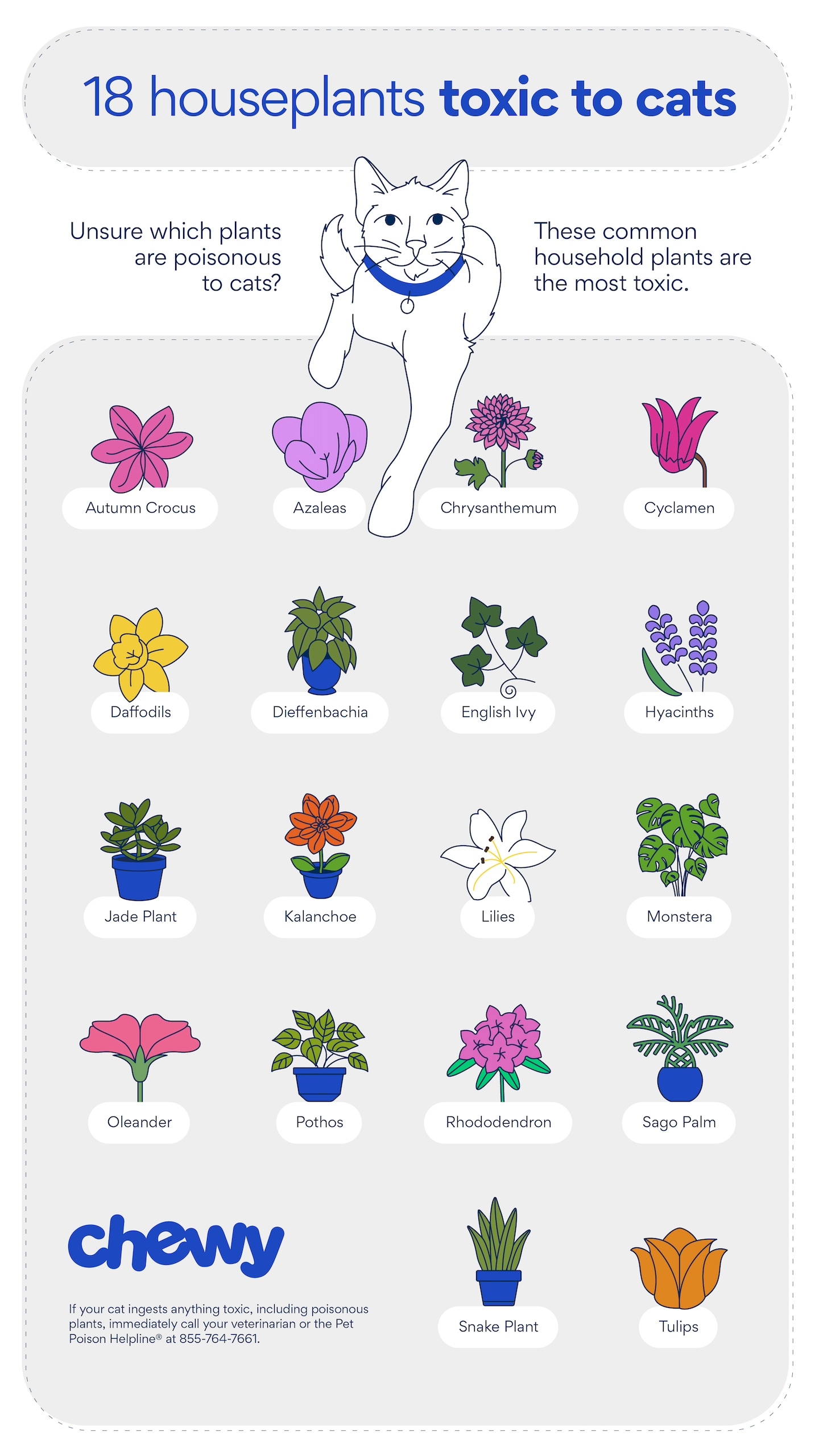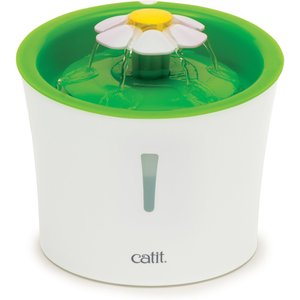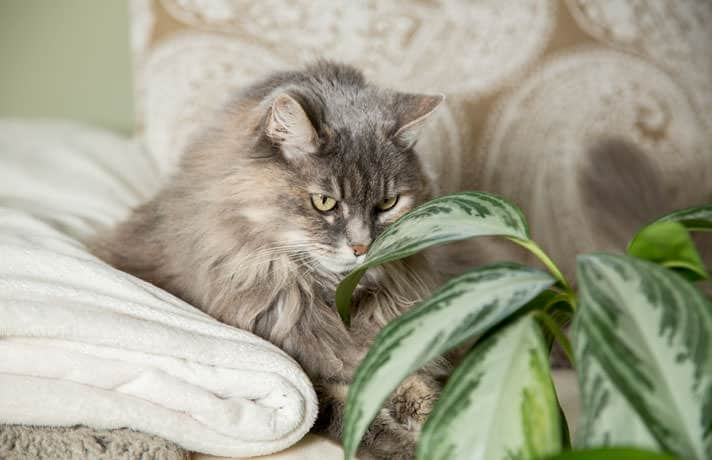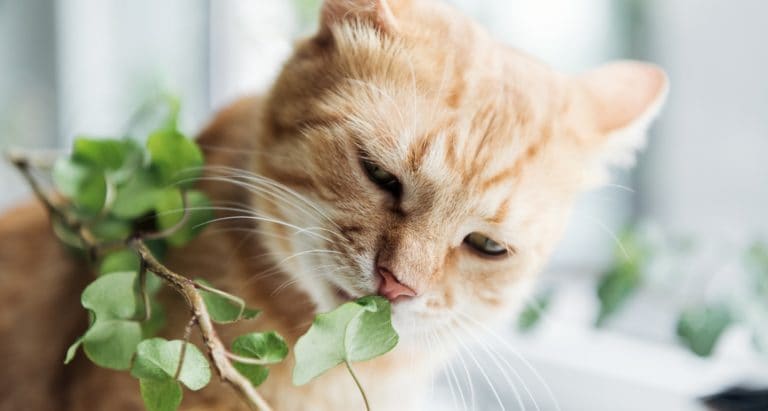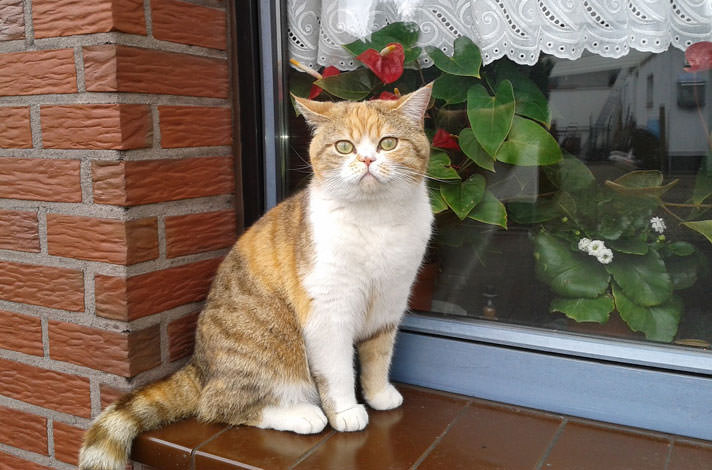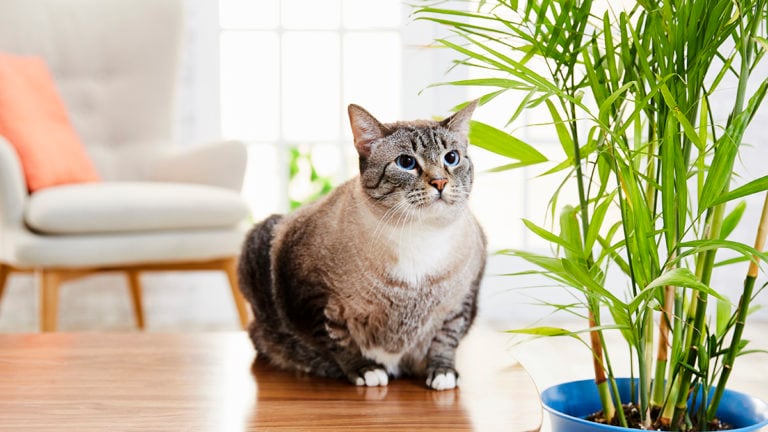Whether in your yard or in your home, you’ll want to keep certain plants and flowers away from your feline companions. There are quite a few plants that are toxic to cats; and the toxicity of various plants and flowers can range from mild to severe, depending on the poisonous component of the plant.
The ASPCA® Animal Poison Control Center reported that, in 2023, more than 8% of all calls were related to pets ingesting plants toxic to them, making plants and fungi sixth on their list of the top 10 pet toxins.
What is the most toxic plant for cats? That would be the lily. "Lilies are a very big deal because they cause acute, potentially fatal kidney failure," says integrative veterinarian Carol Osborne, DVM, of the Chagrin Falls Pet Clinic, in Chagrin Falls, Ohio.
You might wonder exactly what flowers are poisonous to cats and what plants are toxic to cats. Here’s a list of common plants poisonous to cats to keep away from cats and what to do if your cat eats a toxic plant.
In This Guide:
18 Common Plants Poisonous to Cats
Click to learn more (or keep scrolling!).
1. Autumn Crocus
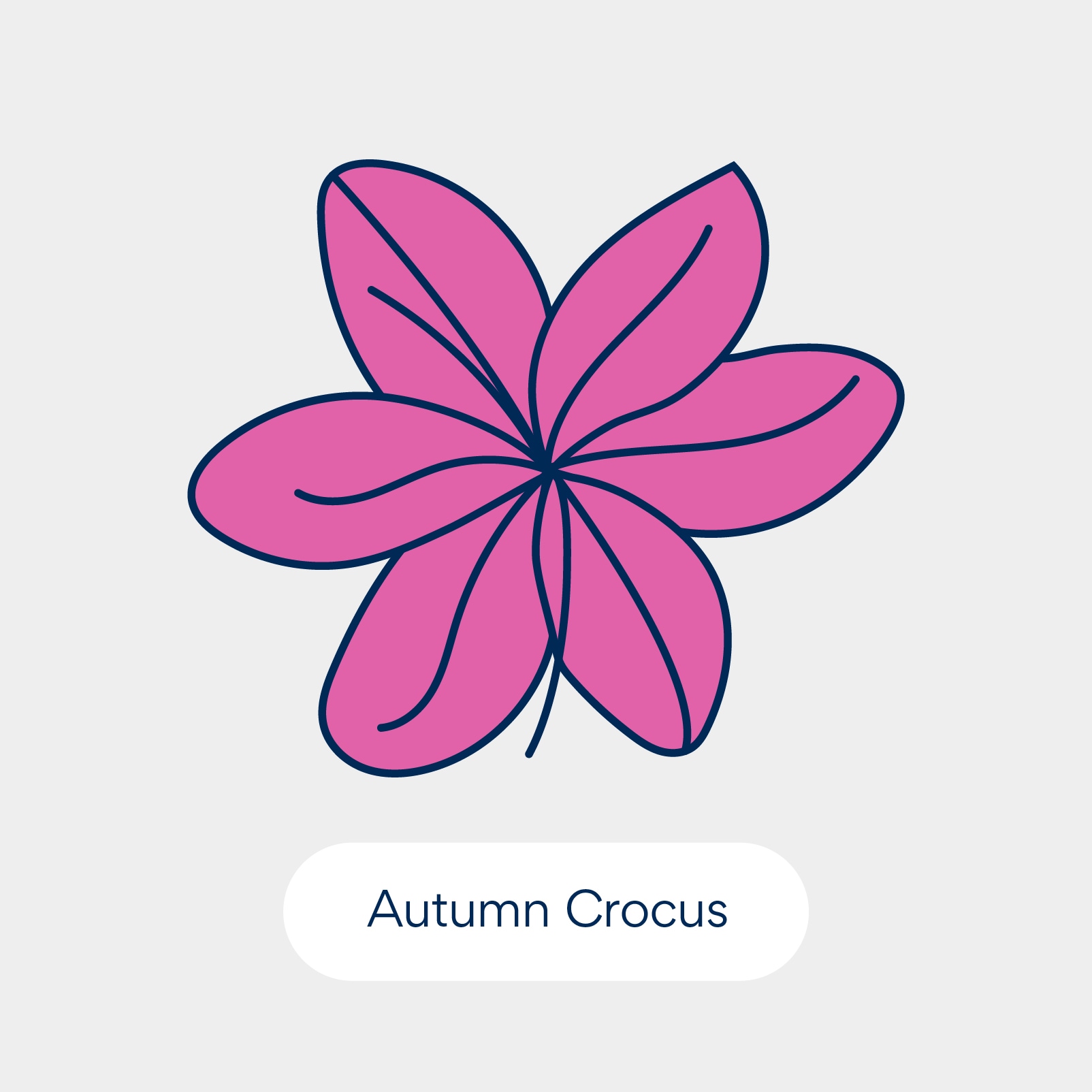
The autumn crocus (Colchicum autumnale), also known as meadow saffron or naked lady, is a common ornamental flowering plant that blooms in the fall.
While also poisonous to dogs and horses, the plant is especially toxic to cats because of its alkaloid colchicine (a natural compound that disrupts cell division) content. All parts of the plant are highly toxic.
Cats who ingest autumn crocus might have the following symptoms:
- Gastrointestinal (GI) signs, like drooling, vomiting, and bloody diarrhea
- Breathing difficulties
- Seizures
- Kidney and liver damage
- Death
Symptoms might be evident shortly after ingestion or could take days to appear.
2. Azaleas
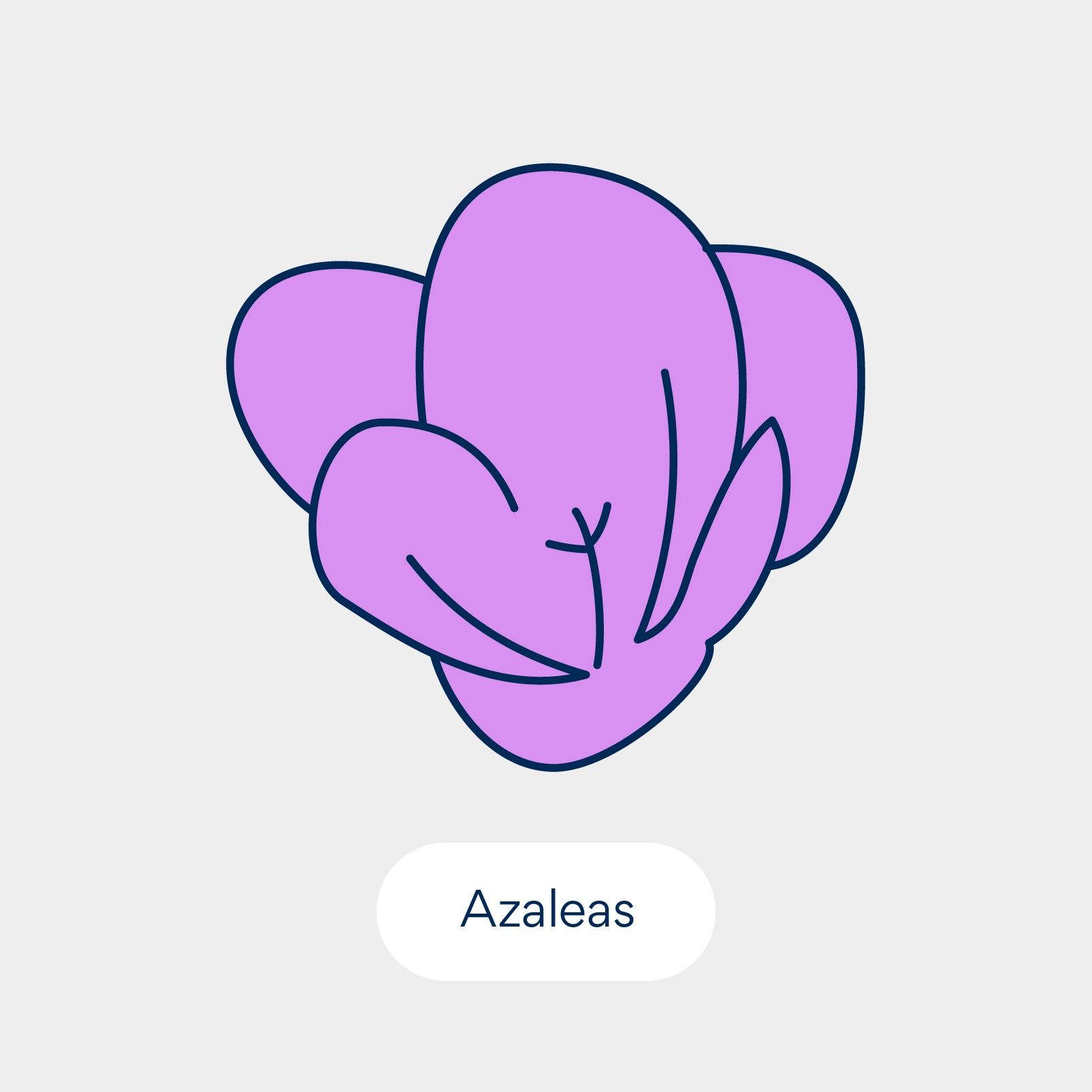
Azaleas are a species of flowering shrubs and small trees that are toxic to cats.
There are more than 1,000 species in this family of plants, and the degree of toxicity varies from moderate to severe, according to the Pet Poison Helpline®.
The toxic component of these plants is a type of neurotoxin called a grayanotoxin. Grayanotoxins disrupt sodium balance, negatively affecting your cat’s muscles, including the heart. All parts of the plant are toxic, and ingesting a tiny amount of the plant can result in a cat being poisoned.
Symptoms of azalea or rhododendron poisoning include:
- GI signs, like drooling, vomiting, diarrhea, and lack of appetite
- Heart arrhythmias
- Weakness
- Tremors
- Temporary blindness
- Seizures
- Coma
- Death
If you have this plant in your yard, don’t allow your cat to come into contact with it, and avoid bringing flowers or plant clippings into the house.
3. Chrysanthemum
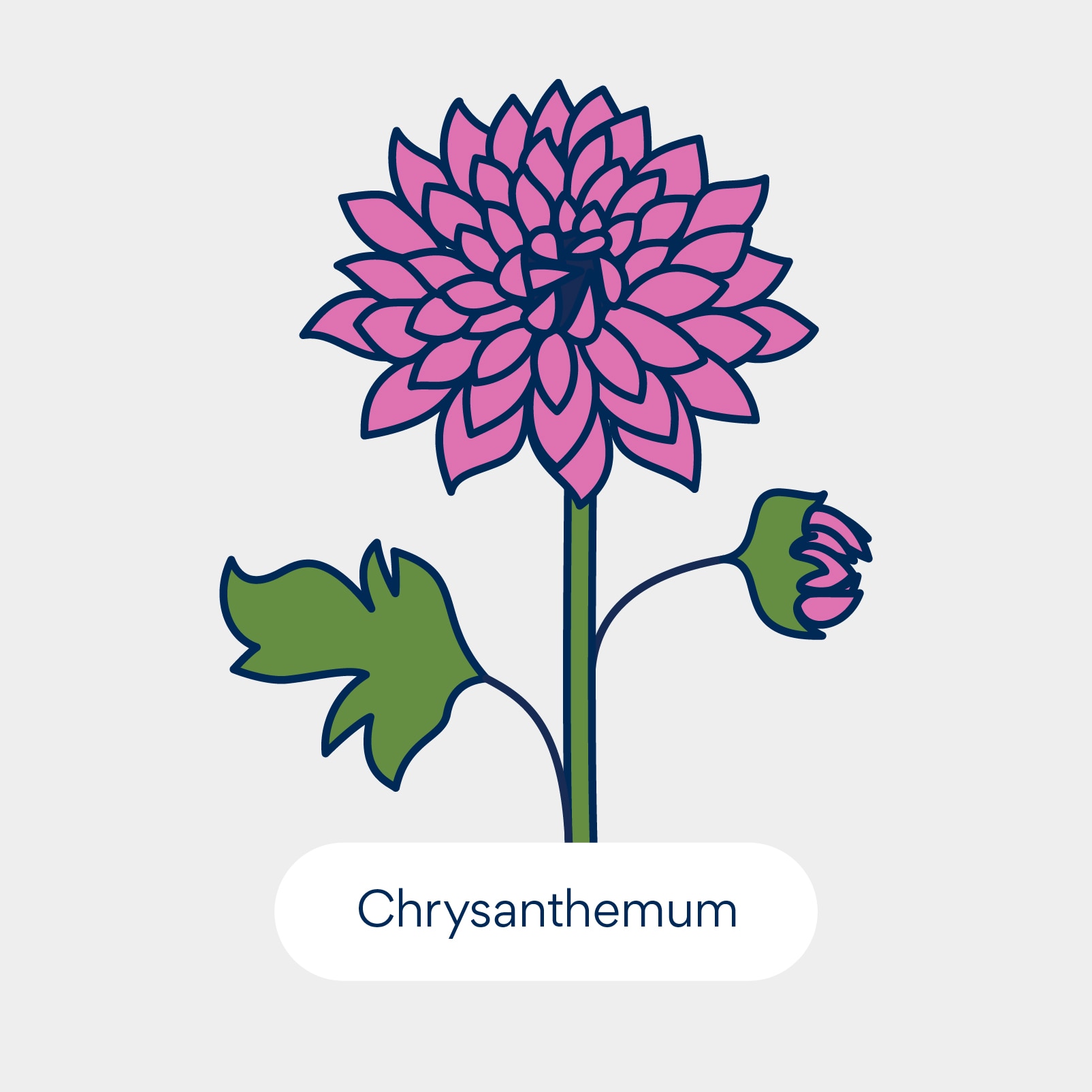
Chrysanthemums (Chrysanthemum spp.) belong to the Compositae family of plants. Commonly called “mums,” these flowering plants include about 40 different species.
The leaves and flowers of chrysanthemums contain many different compounds that can be toxic to cats, including:
- Sesquiterpene: A specific terpene (a naturally occurring compound often responsible for plant scents) that can cause toxicity or allergic reactions in cats
- Lactones: Metabolites (substances produced or used during metabolism) of sesquiterpene that can also cause toxicity
- Pyrethrins: Natural pesticides that deter insects but can be toxic to cats (these are sometimes used to make flea and tick medication)
Even just a small amount of these toxic compounds can cause several signs of poisoning, including:
- Vomiting
- Diarrhea
- Reduced appetite
- Excessive saliva/drooling
- Unsteadiness
- Skin inflammation
While considered a mild toxin, you should call the Pet Poison Helpline at 855-764-7661 for more guidance if your cat has eaten any part of the chrysanthemum plant.
To prevent any adverse effects, keep these plants out of the house and away from the yard.
4. Cyclamen
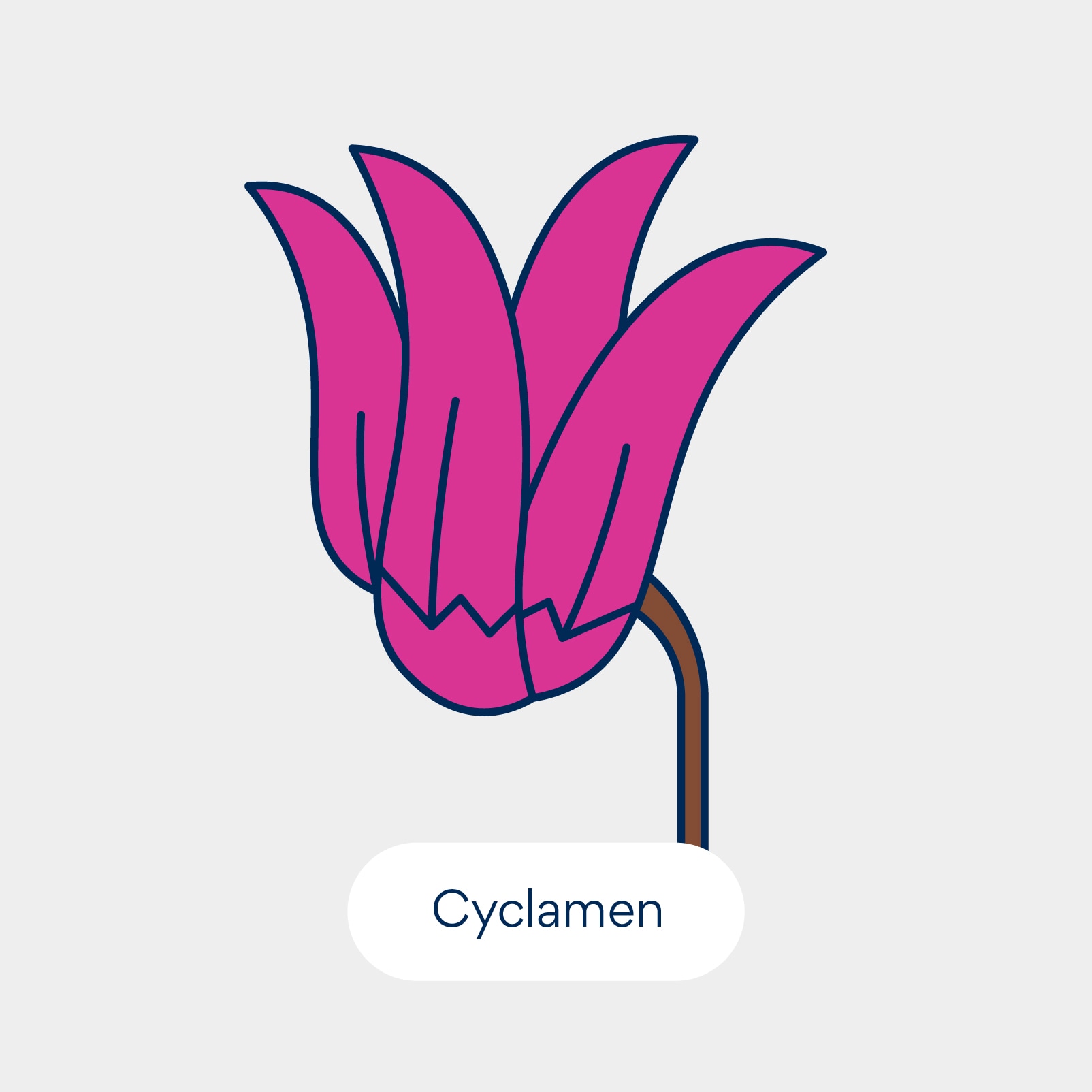
Cyclamen (Cyclamen spp.), also known as Persian violet and sowbread, is a genus of more than 20 species of perennial flowering plants that are often kept indoors.
The tubers and roots are the most toxic parts of cyclamen, but all parts of the plant contain the toxic components, called saponins.
Signs of cyclamen toxicity involving small amounts of the plant include:
- Drooling
- Vomiting
- Diarrhea
If a cat ingests large quantities of cyclamen, they can experience:
- Abnormal heart rate and rhythm
- Seizures
- Death
5. Daffodils (Narcissus)
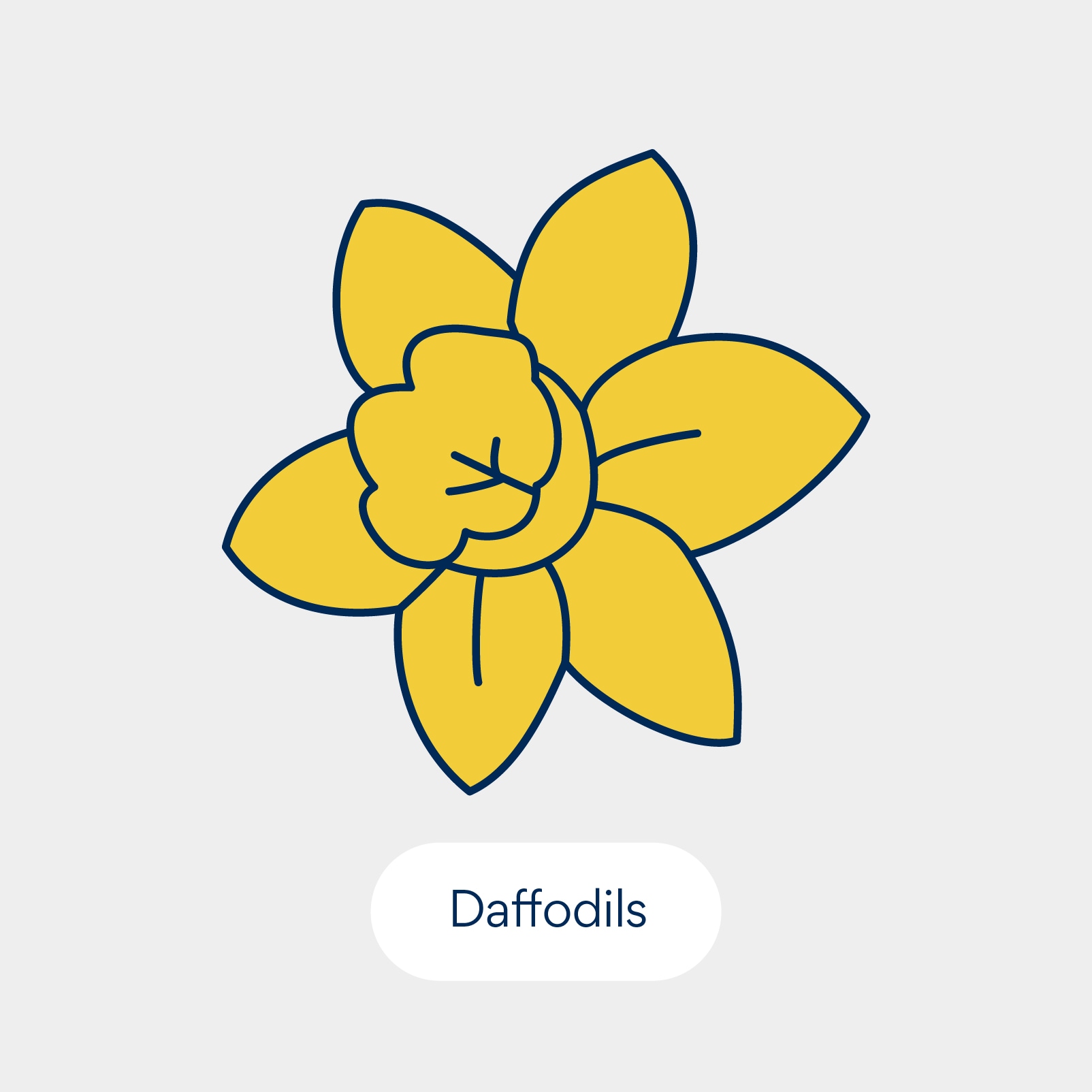
Most plants that fall into the genus Narcissus, including the daffodil (also called jonquil, paperwhite, or narcissus), are flowering spring perennials.
All parts of the plant contain the poisonous agent lycorine, but the bulbs are the most toxic.
Lycorine causes:
- Drooling
- Vomiting
- Diarrhea
- Abdominal pain
In some cases, cats who ingest daffodils and other plants in the genus Narcissus experience:
- Cardiac arrhythmia
- Extremely low blood pressure
- Breathing difficulties
- Convulsions
Do not keep daffodils or related plants in the house, and do not plant daffodils in the yard if your cat has access to them. Gardeners must take care to keep daffodil bulbs away from cats.
6. Dieffenbachia
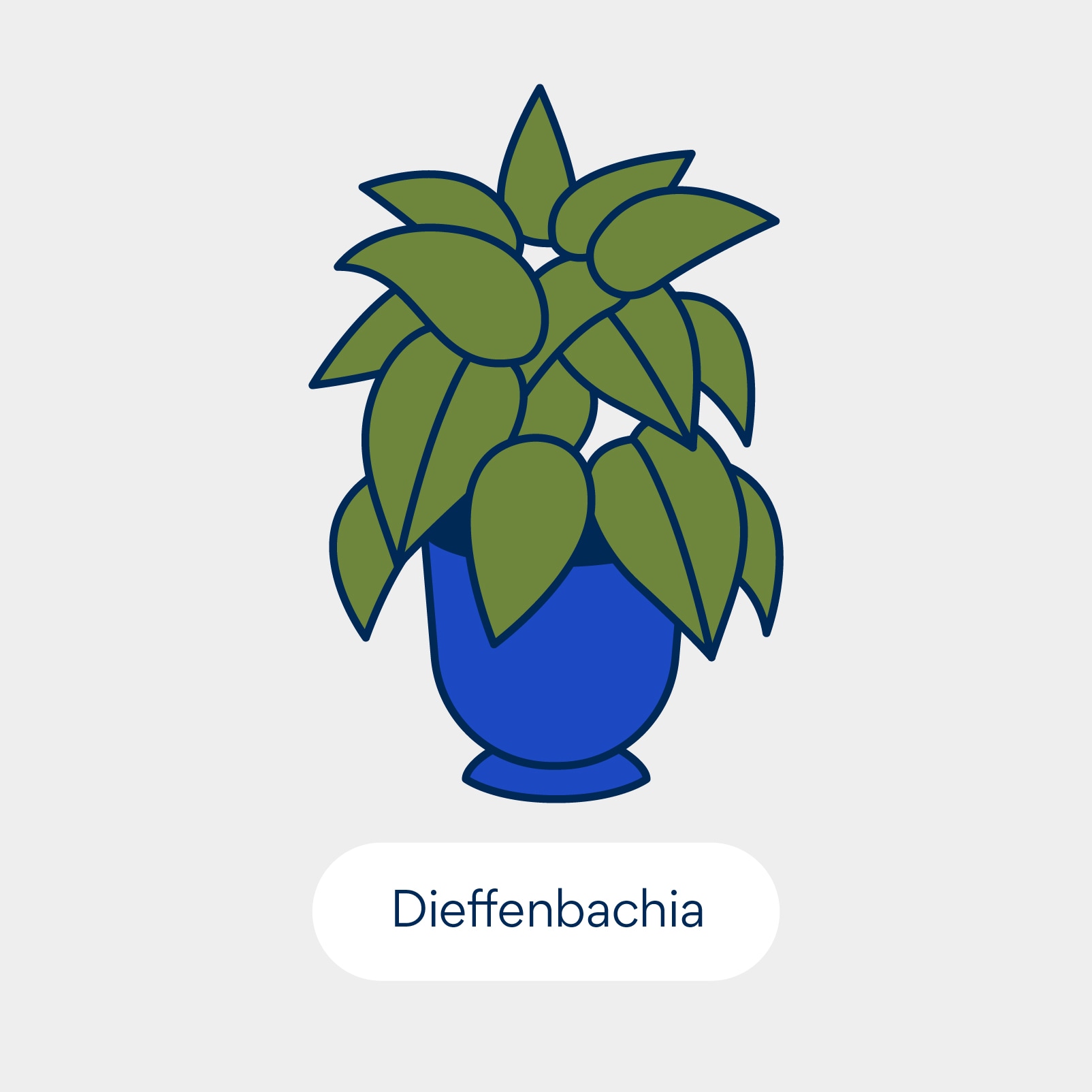
Dieffenbachia (Dieffenbachia spp.), also known as charming dieffenbachia, dumb cane, exotica perfection, giant dumb cane, gold dieffenbachia, spotted dumb cane, tropic snow, and variable dieffenbachia, is part of a genus of tropical flowering plants in the Araceae family.
This common houseplant contains insoluble calcium oxalate crystals, which cause oral irritation, including:
- Burning feeling in the mouth
- Drooling
- Vomiting
- Difficulty swallowing
Although it’s generally not deadly, exposure to this plant can be extremely painful for cats, so these plants should not be kept in homes with cats.
7. English Ivy
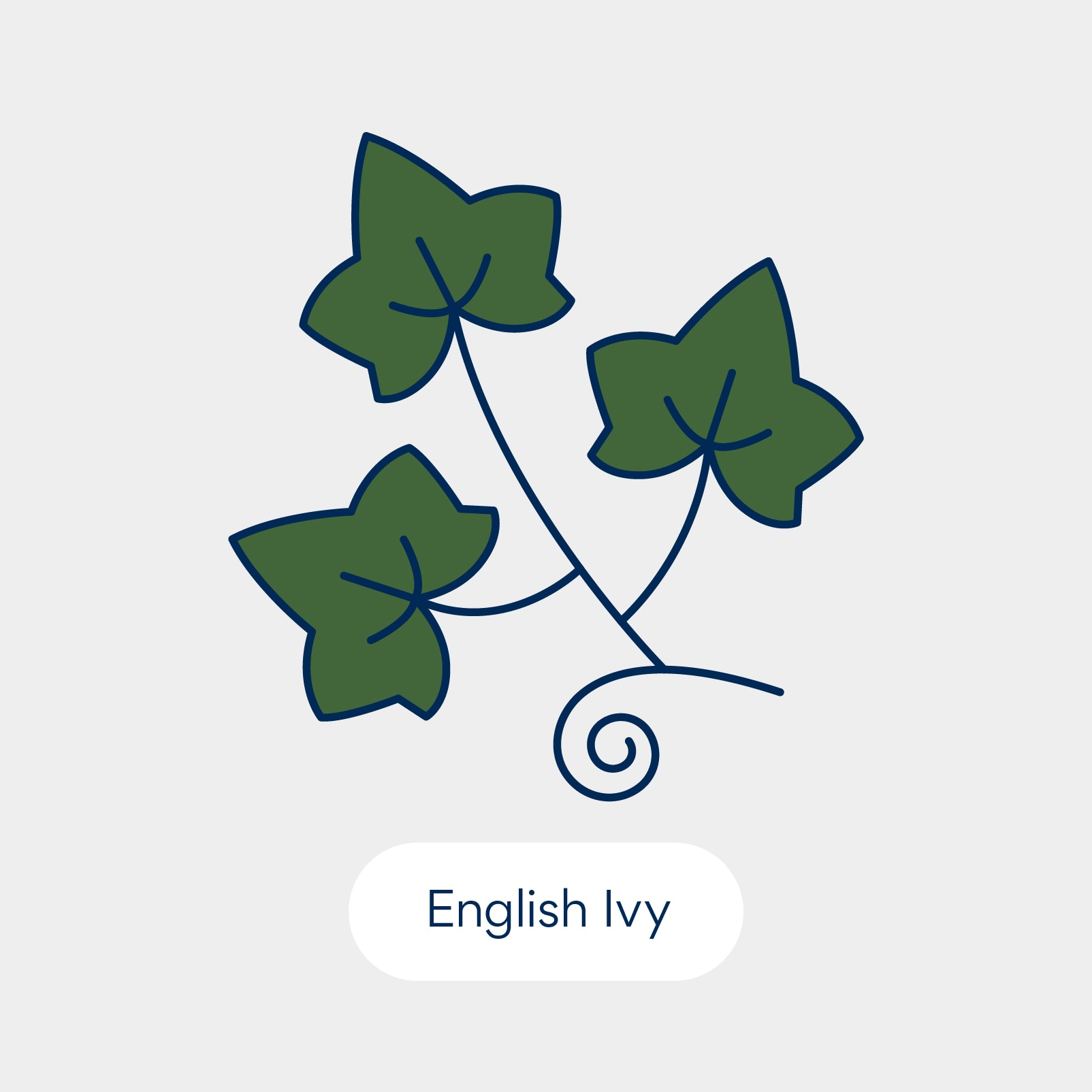
English ivy (Hedera spp.) is a flowering perennial that’s fast-growing and invasive. It also goes by the names common ivy, European ivy, glacier ivy, and sweetheart ivy.
Both the leaves and the berries of the plant are toxic to cats, although they’re considered a mild toxin.
English ivy plants also contain toxins called pentacyclic terpenoids, which can cause:
- Drooling
- Vomiting
- Diarrhea
If your cat ingests English ivy, the signs typically resolve themselves quickly with no need to visit a veterinarian. However, if your cat has persistent vomiting or diarrhea, go to the vet.
8. Hyacinth
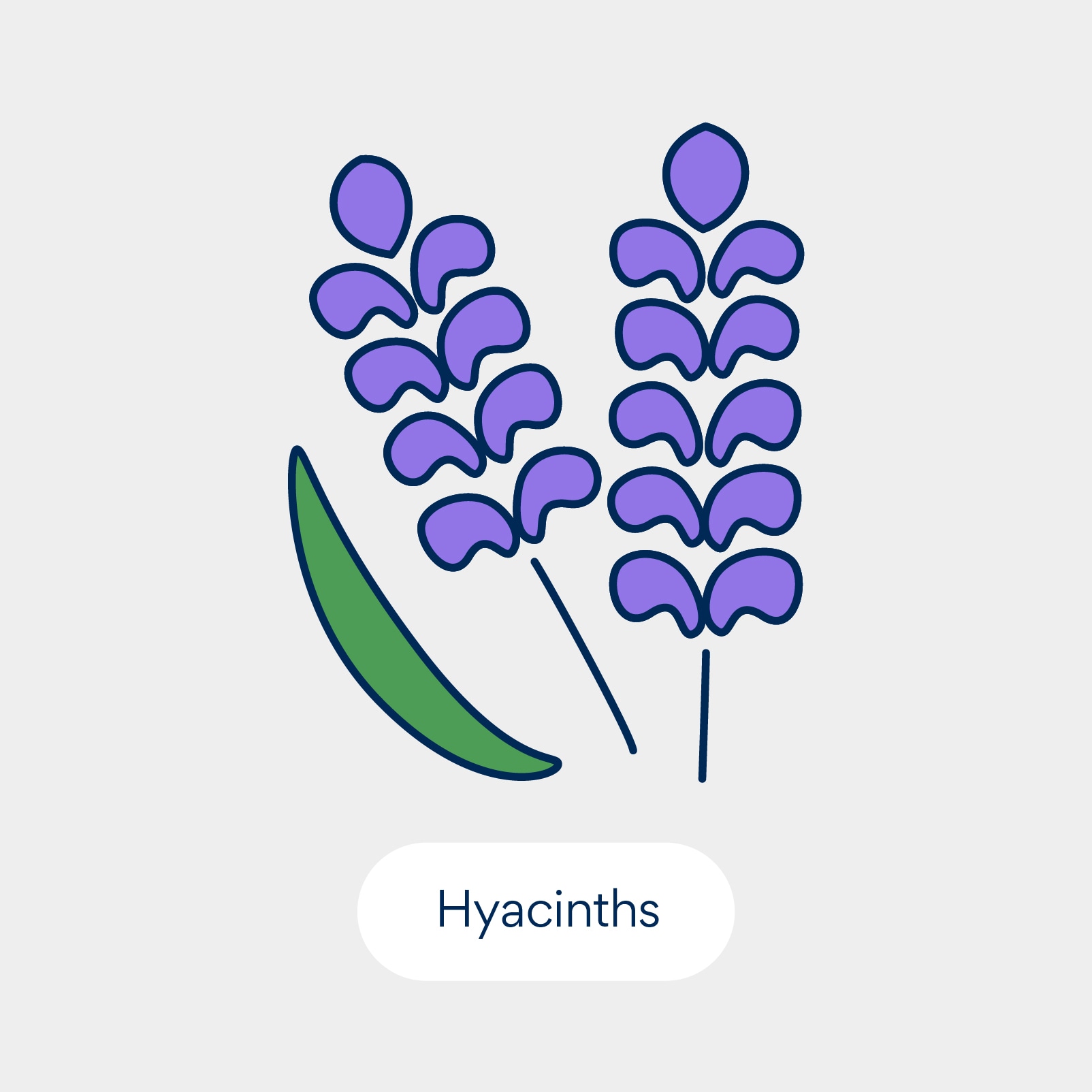
Hyacinths belong to the same plant family as tulips (Liliaceae).
While all parts of the plant are toxic to cats, the toxins, which are allergenic lactones or alkaloids, are very concentrated in the bulb, the underground stem from which the plant grows.
Chewing on the bulb can cause irritation in your cat’s mouth and esophagus and potentially induce an allergic reaction, which can cause the following clinical signs:
- Drooling
- Nausea
- Vomiting
- Diarrhea
- Stumbling or uncoordinated walking
- Hives
- Facial swelling
- Difficulty breathing
- Rapid breathing
- Increased heart rate
If you think your cat has ingested hyacinth, call the Pet Poison Helpline or your local emergency veterinarian for guidance on what to do next.
9. Jade Plant
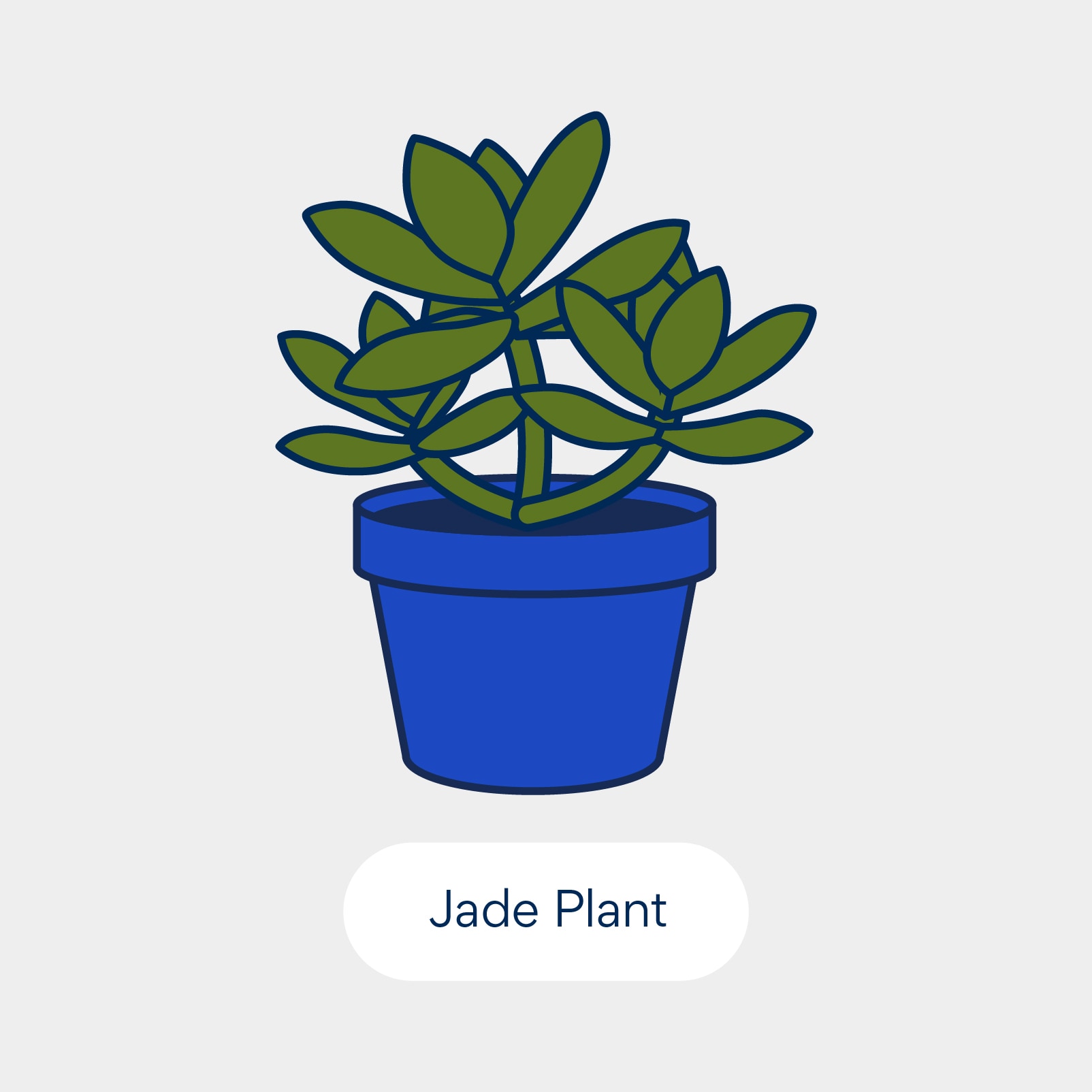
The jade plant (Crassula ovata) is a resilient, easy-to-grow succulent that’s a favorite among people who have trouble keeping plants alive. Also called a dwarf rubber plant or a friendship plant, the jade plant is considered mildly toxic to cats.
If your cat nibbles on any part of the plant, they might experience:
- Vomiting
- Decreased (or no) appetite
- Lethargy
- Stumbling
Often, these signs will resolve on their own, but if your cat doesn’t seem to be getting better, seek veterinary attention.
Because the jade plant is only mildly toxic, you might be able to keep it in your home away from your cats, but if your feline likes to nibble, you’re better off choosing a non-toxic plant instead.
10. Kalanchoe
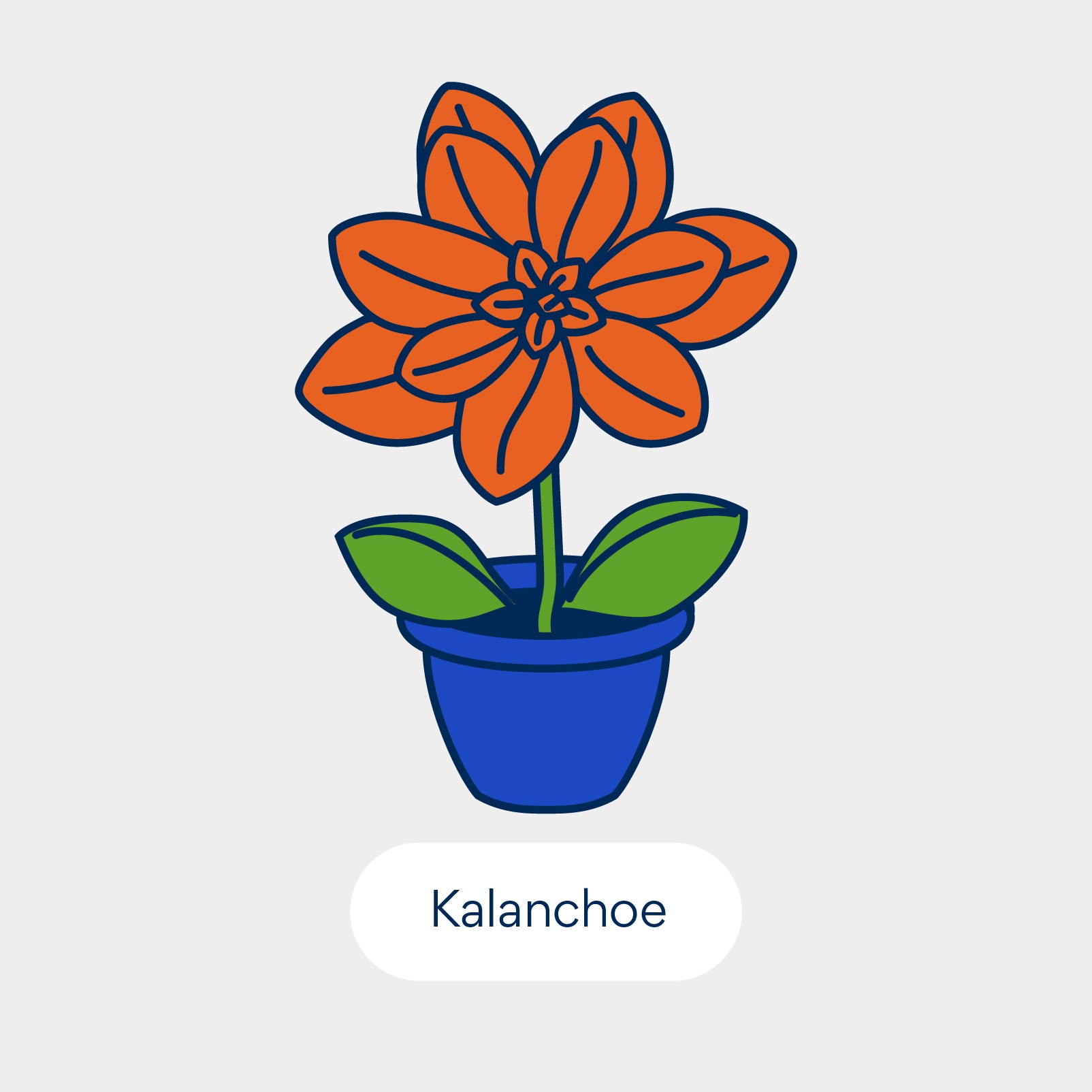
The flowering houseplant kalanchoe (Kalanchoe spp.) is also known as the mother-in-law plant, devil’s backbone, mother of millions, and chandelier plant.
All parts of this plant contain toxins called bufadienolides (steroid hormones), which generally cause GI signs, including:
- Drooling
- Vomiting
- Diarrhea
Though rare, if cats ingest large quantities of kalanchoe, they might experience more severe symptoms, including:
- Heart arrhythmia
- Collapse
- Seizures
11. Lilies
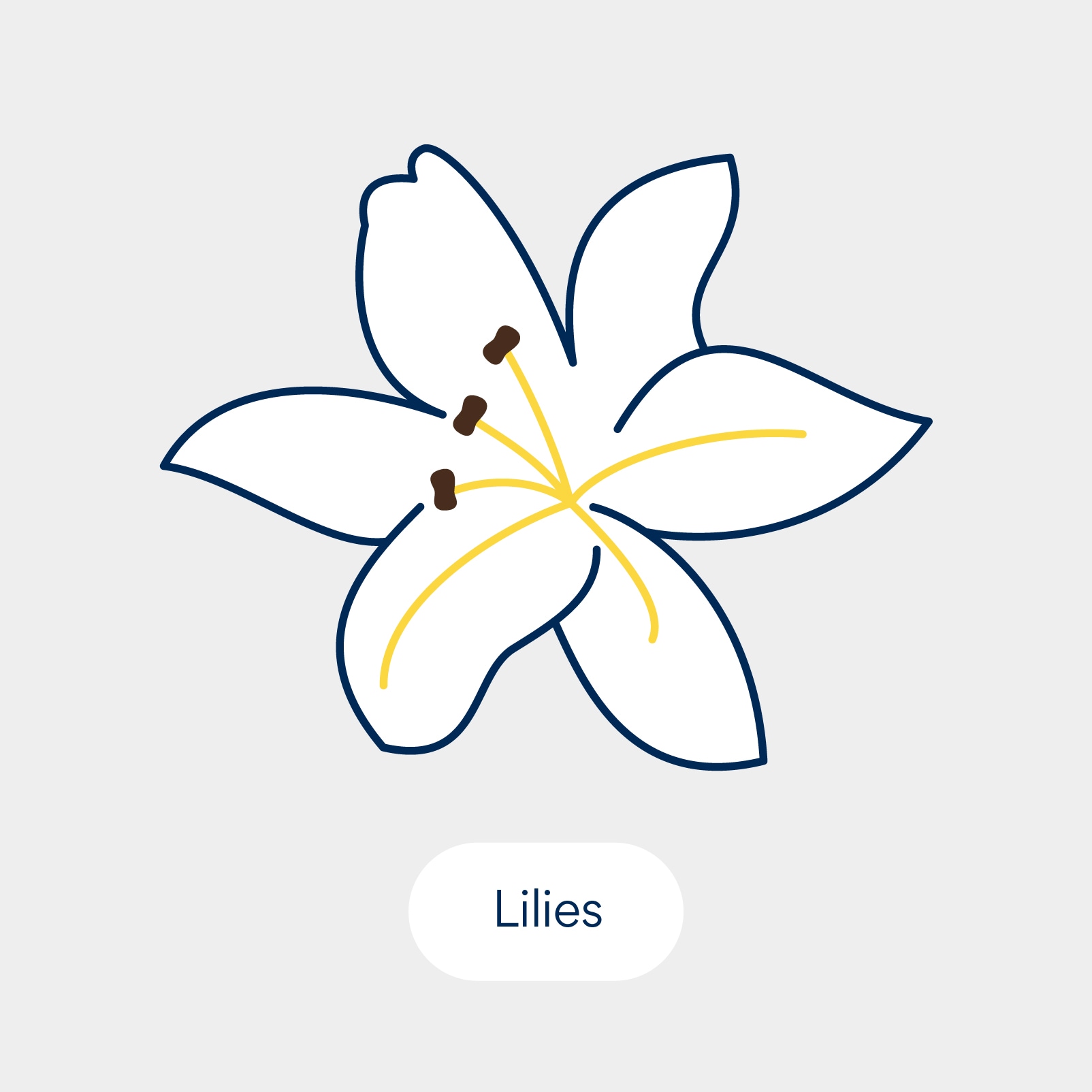
Lilies are extremely dangerous to cats.
Although many plants contain the word “lily” in their name, certain species are the most dangerous to cats, including Asiatic lilies, Easter lilies, Japanese show lilies, rubrum lilies, stargazer lilies, red lilies, tiger lilies, Western lilies, wood lilies, and daylilies.
“Easter lilies are very dangerous for cats; ingestion of any part of the plant, or even the pollen, can cause kidney failure,” says ASPCA Animal Poison Control Center Senior Director of Toxicology Tina Wismer, DVM, DABVT, DABT.
Cats need only ingest a tiny bit of the aforementioned lilies (for instance, chewing on one or two petals or leaves) to take in enough toxin to cause death.
Even just licking the pollen from the flowers or drinking water from the vase of lilies can spell death for a cat, Dr. Wismer says.
If you suspect that your cat might have come in contact with a lily, call your veterinarian or poison control immediately. Do not wait, as prompt treatment can mean the difference between life and death.
Never keep lilies in the house, Dr. Wismer says—the risk is too high.
12. Monstera
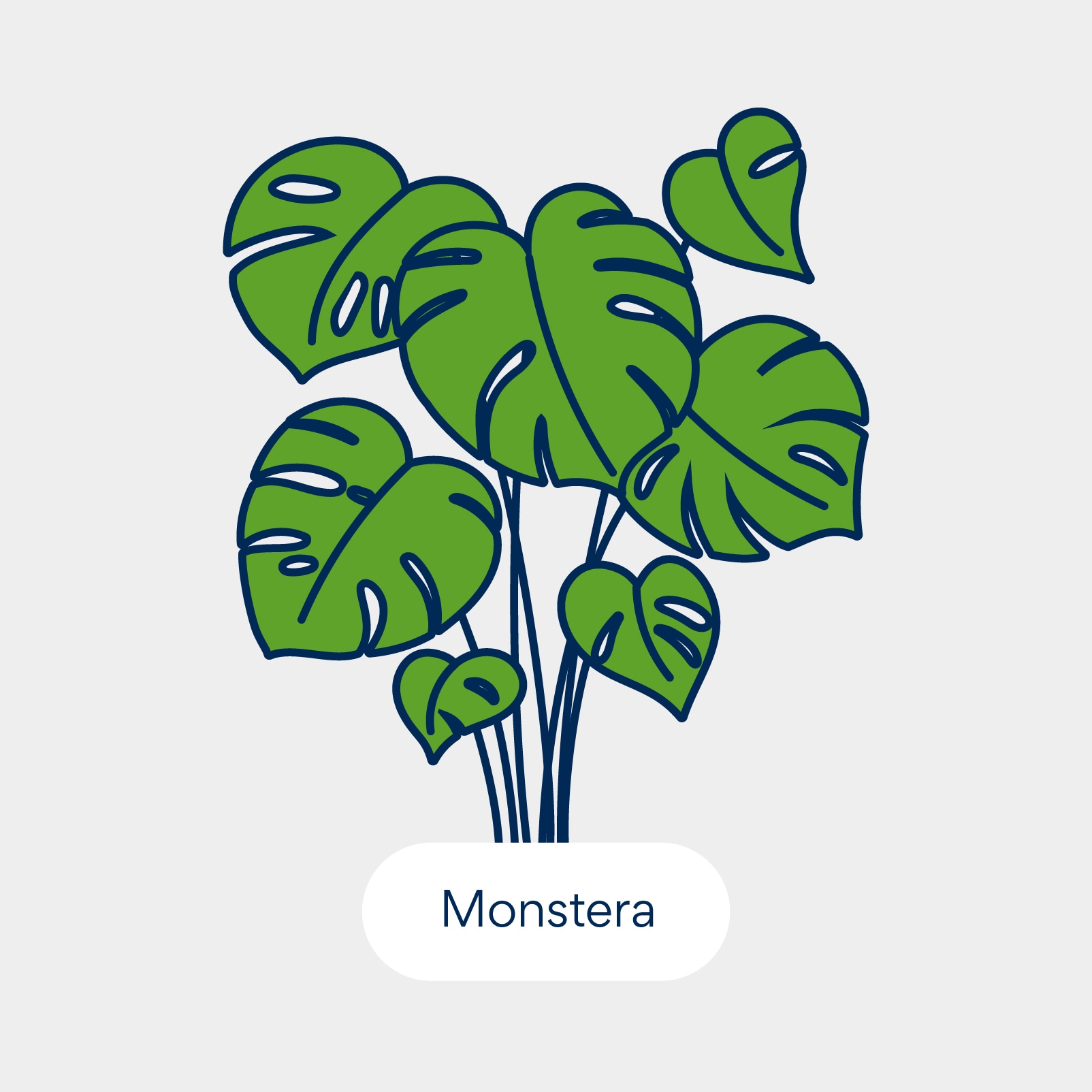
The monstera, also called the split-leaf philodendron or Swiss cheese plant, is a household (and Instagram) favorite with more than 50 different species. But if you have cats, you should avoid it in your home.
That’s because all parts of the plant contain insoluble calcium oxalate crystals that can irritate the mouth and digestive tract. This can cause:
- Drooling
- Pawing at the mouth
- Oral pain
- Decreased appetite
- Vomiting
In rare cases, the upper airway can swell, causing breathing difficulty.
Because of the potential of serious complications, you should seek emergency veterinary care if you think your cat has ingested any part of the monstera plant.
13. Oleander
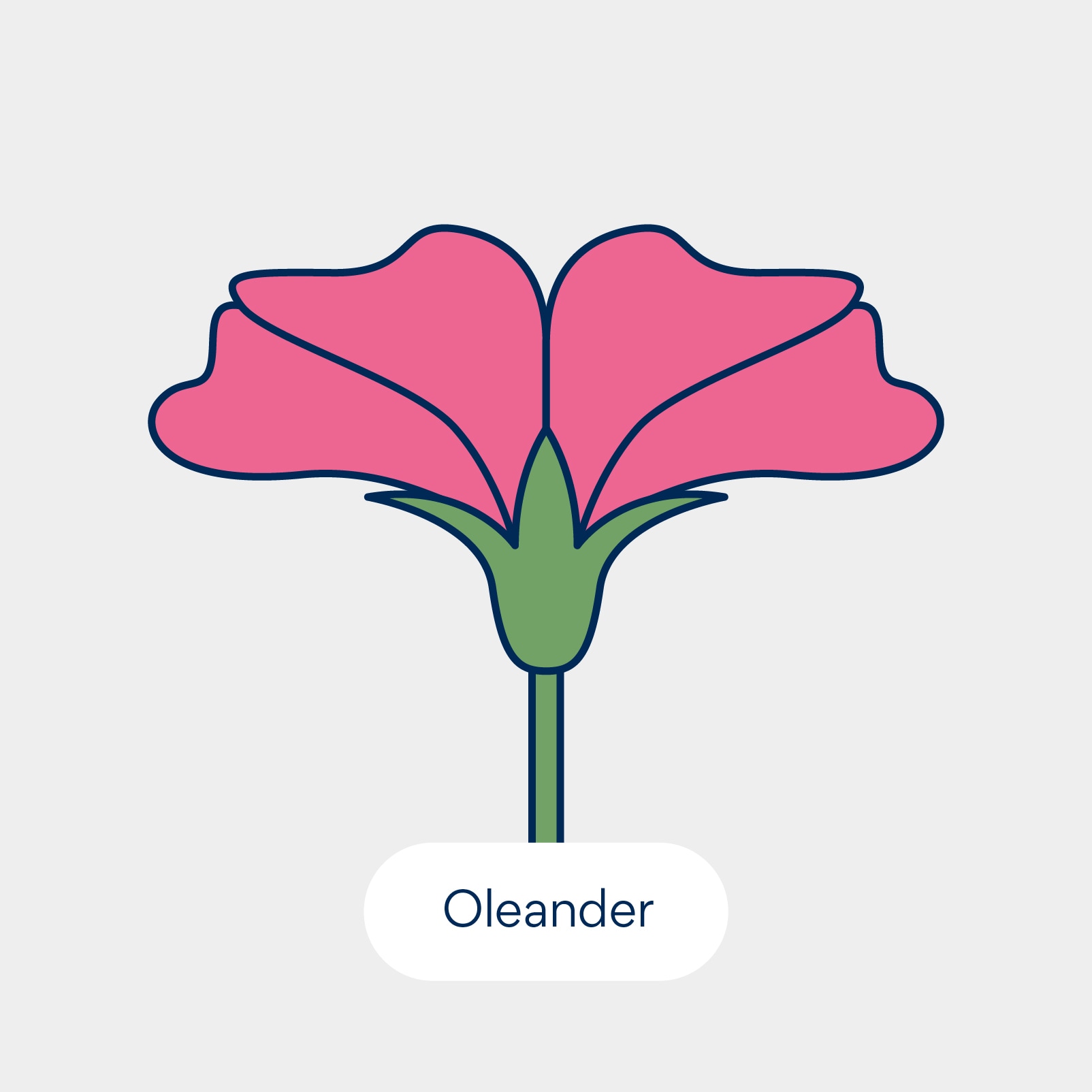
Oleander (Nerium oleander), also known as white oleander or rosebay, is a popular outdoor flowering shrub found in warm climates.
Oleander contains cardiac glycoside toxins, which adversely affect the heart muscle.
Symptoms of oleander ingestion in cats include:
- Drooling
- Vomiting
- Diarrhea
- Lack of coordination
- Tremors
- Seizures
- Fatal heart abnormalities
All parts of the oleander plant are toxic, including the water in a vase of these flowers.
14. Pothos
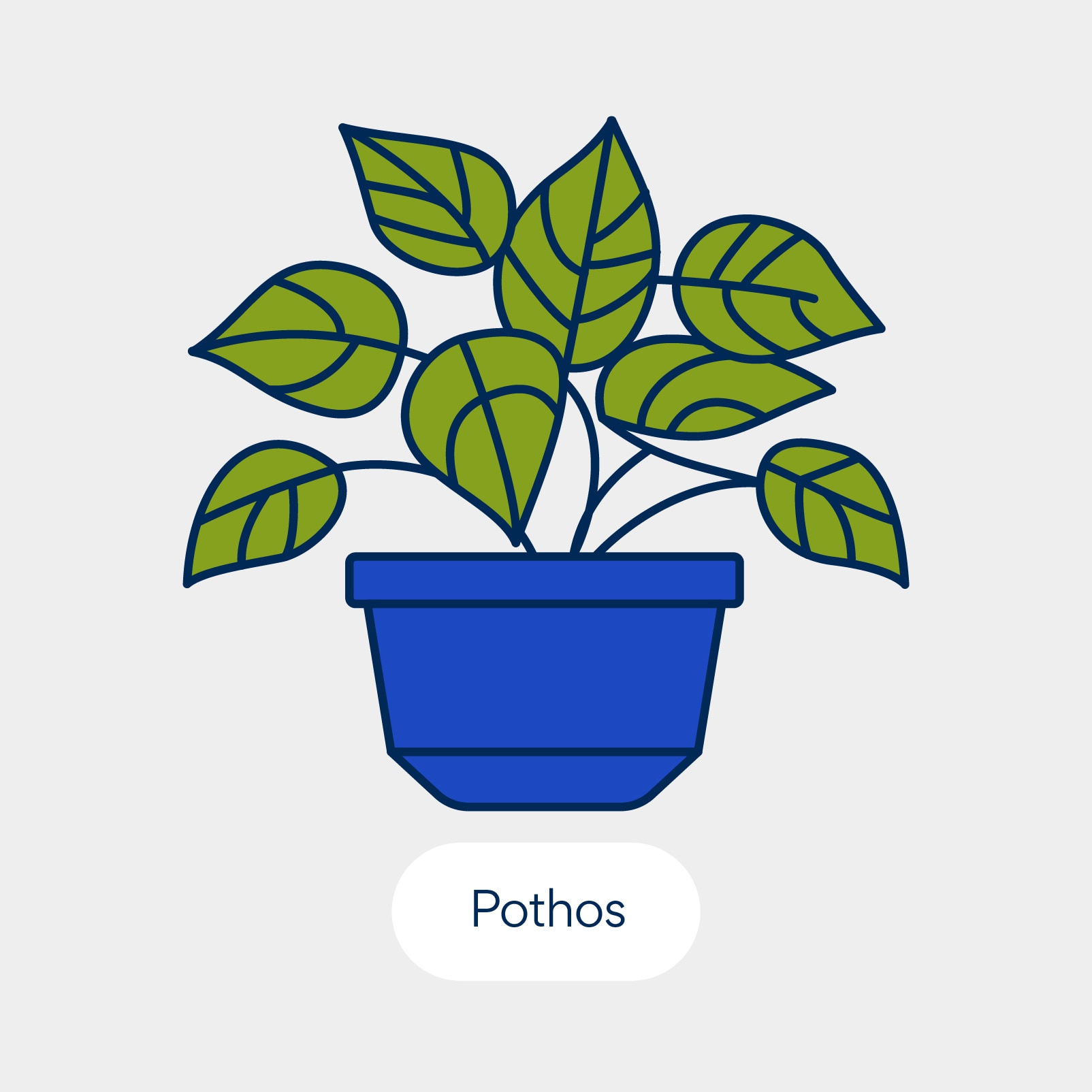
All parts of the pothos plant (Scindapsus spp.) contain insoluble calcium oxalate crystals that are toxic to cats.
The Pet Poison Helpline classifies the pothos as having mild to moderate toxicity, saying it can cause mouth and GI irritation that shows up in cats as:
- Drooling
- Pawing at the mouth
- Decreased appetite
- Vomiting
- Mouth pain
In the rare severe cases, the crystals can cause swelling of the upper airway that makes it difficult to breathe.
If your cat eats any part of a pothos plant, seek immediate veterinary care.
15. Rhododendrons
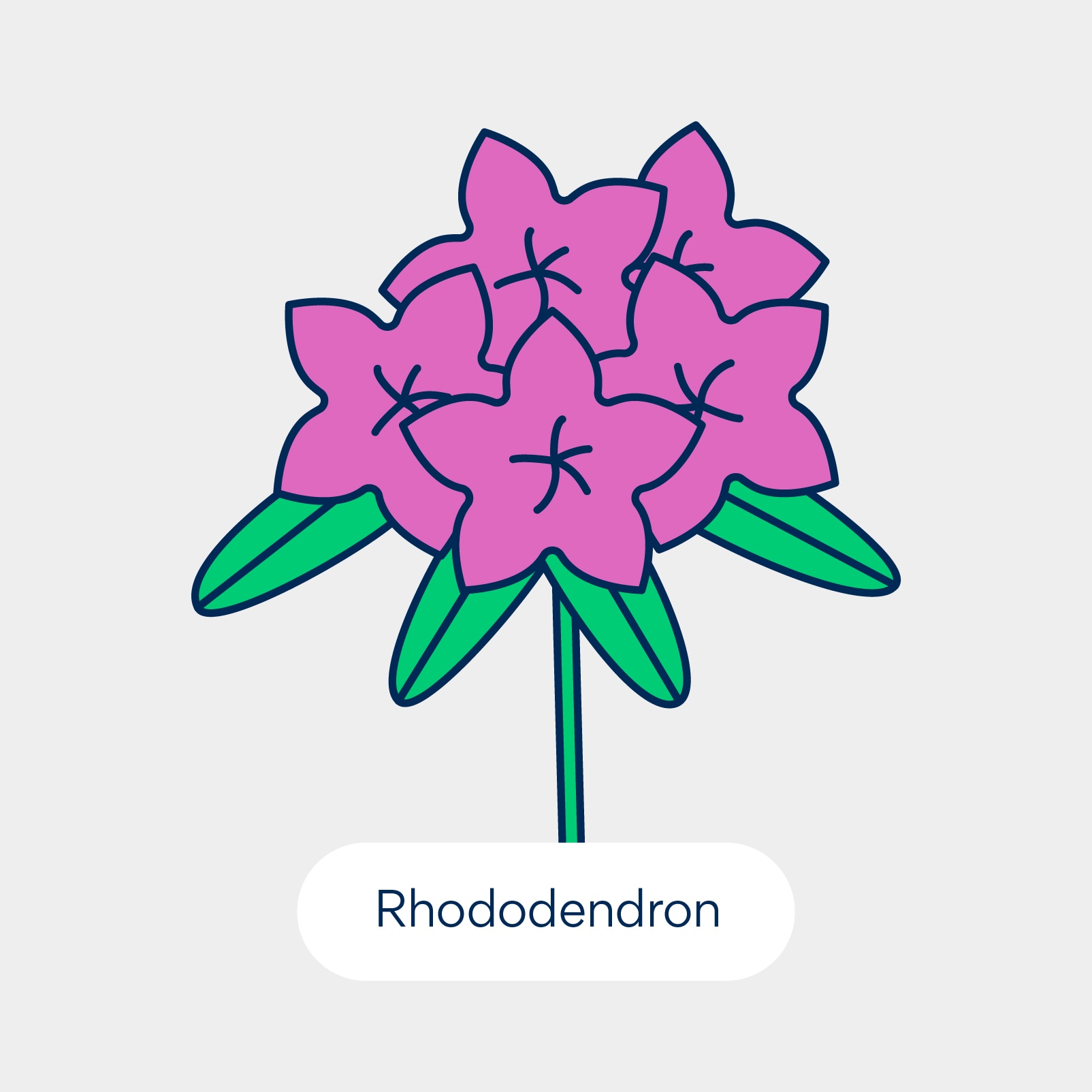
Rhododendrons (Rhododendron spp.) are woody, rounded shrubs that typically grow pink or mauve flowers. There are more than 1,000 rhododendron species.
Rhododendrons are considered severely toxic to cats due to compounds called grayanotoxins, also found in azaleas.
According to the Pet Poison Helpline, all parts of the plant are toxic, and your cat ingesting an amount of rhododendron totaling just 0.2% of their body weight can cause poisoning.
Clinical signs of rhododendron poisoning in cats include:
- Drooling
- Vomiting
- Diarrhea
- Stomach pain
- Reduced appetite
- Abnormal heart rate
- Weakness
- Low blood pressure
- Tremors
- Temporary blindness
- Seizures
- Coma
If your cat ingests rhododendron, seek emergency veterinary care immediately. If you act quickly and get treatment swiftly, your cat is likely to recover, so don’t delay!
16. Sago Palm
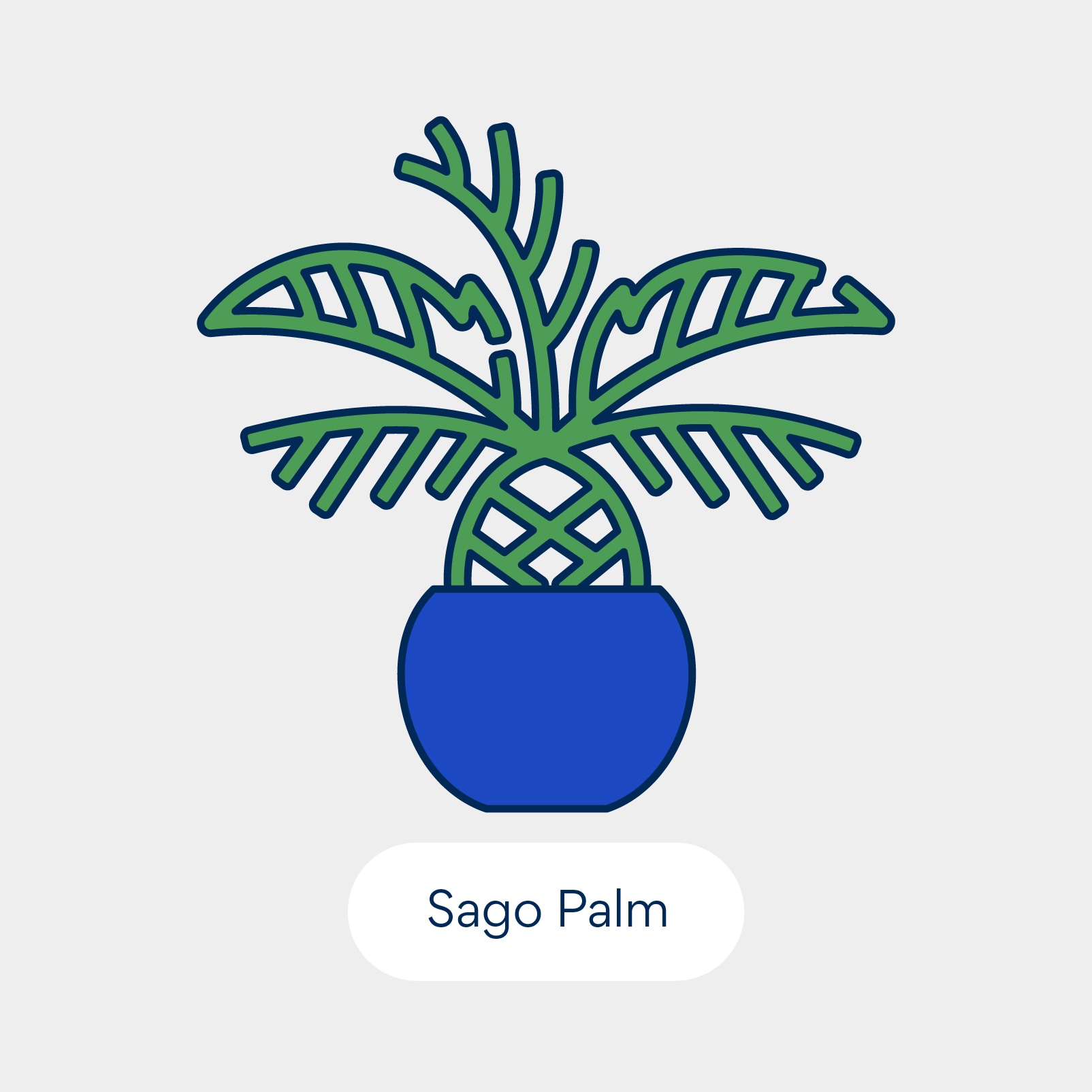
Sago palm (Cycas revoluta), also known as coontie palm, cardboard palm, cycad, and zamia, is a common plant found outdoors in tropical and subtropical areas. Certain sago palms are also kept as houseplants.
All parts of the sago palm plant are toxic, but the seeds are the deadliest. The main toxic compound is cycasin, which causes severe liver damage.
Symptoms of sago palm poisoning in cats include:
- Vomiting and diarrhea
- Black, tarry-looking stool
- Bruising
- Increased thirst
- Lethargy
- Liver failure
- Death
If you suspect your cat has chewed on any part of a sago palm, seek immediate treatment.
Even with quick and aggressive veterinary treatment, the prognosis for survival is only 50%, according to Pet Poison Helpline. So it’s best to avoid having this plant in your home or yard.
17. Snake Plant
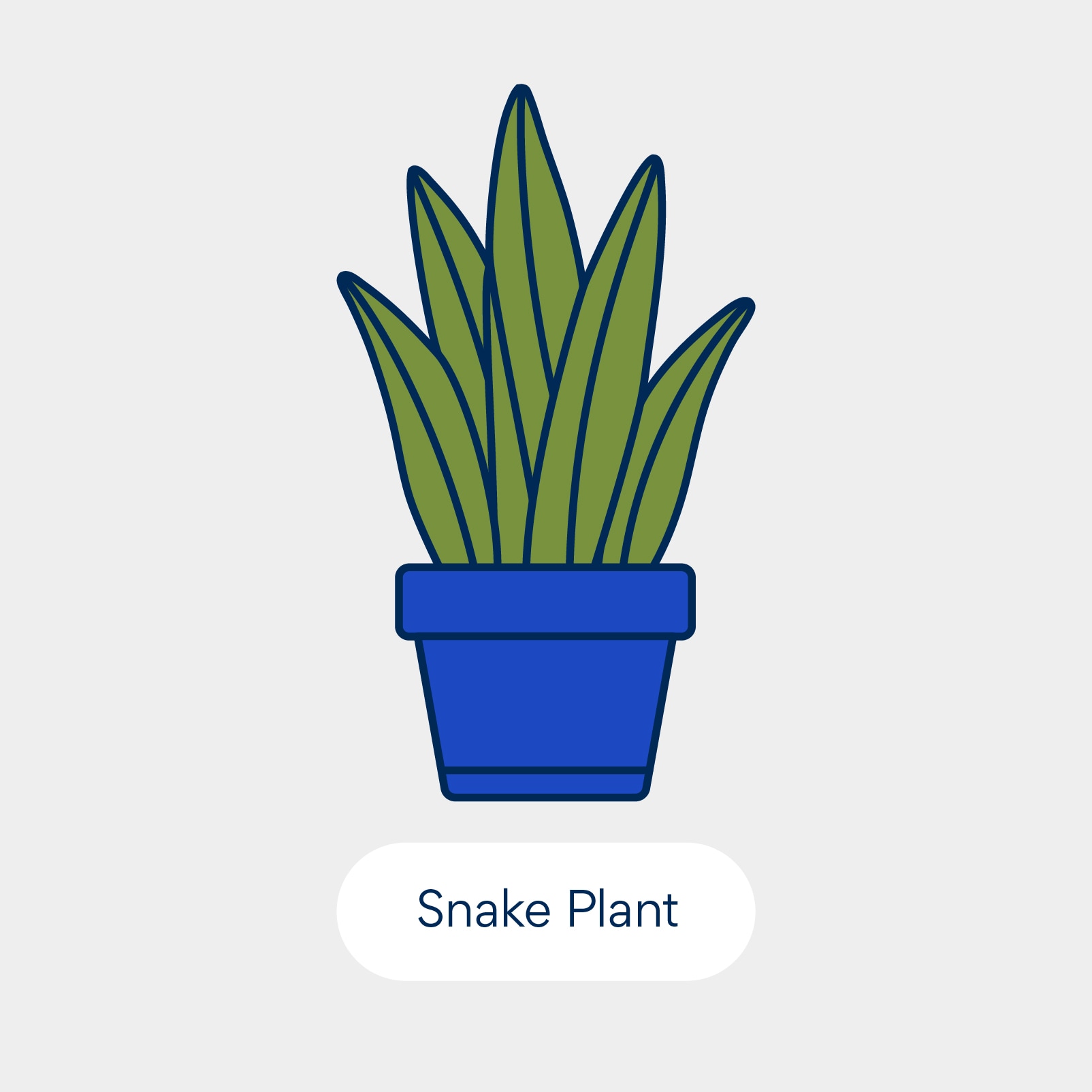
The snake plant (Sansevieria trifasciata) is a resilient, low-maintenance houseplant with tall, snake-like leaves that grow straight up (hence its name). It’s also called a good luck plant, golden bird’s nest, or mother-in-law’s tongue.
All parts of the plant are toxic to cats and can cause digestive upset and symptoms such as:
- Drooling
- Decreased appetite
- Vomiting
- Lethargy
Snake plants have a bitter taste, so your cat is unlikely to ingest a huge amount. That said, if you suspect your curious kitty has nibbled on any part of the plant, you should call the Pet Poison Helpline or your local emergency veterinarian.
18. Tulip

Popular in bouquets and gardens, tulips (Tulipa spp.) are part of the Liliaceae family, which also includes the deadly lily species.
Tulips contain the allergens tulipalin A and tulipalin B. And although all parts of the plant and flower contain these dangerous compounds, they are most concentrated in the bulbs.
Signs of tulip poisoning in cats include:
- Drooling
- Nausea
- Vomiting
- Diarrhea
- Difficulty breathing
- Increased heart rate
What To Do if Your Cat Eats a Toxic Plant
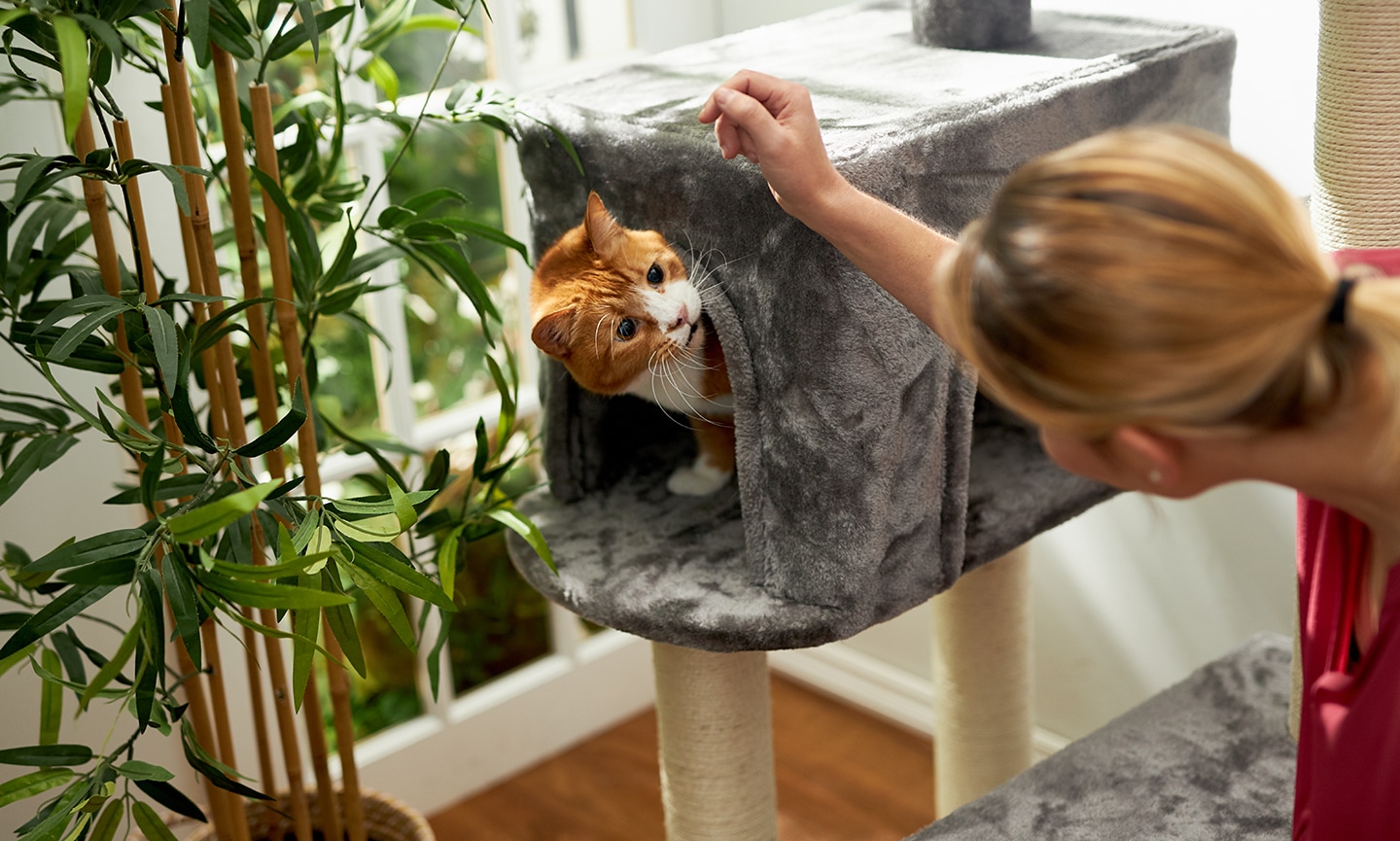
Take Immediate Action
If you suspect that your cat has ingested any part of a plant that’s poisonous to cats—even just chewing or licking the leaves or flowers—take immediate action, says Gary Weitzman, DVM, MPH, CAWA, president and CEO of the San Diego Humane Society.
Call your veterinarian or an animal poison control hotline quickly. The following two animal poison control hotlines are available 24 hours a day, 7 days a week:
- Pet Poison Helpline at 855-764-7661 (an $85 consultation fee applies)
- ASPCA Animal Poison Control Center at 888-426-4435 (consultation fee may apply)
Take Photos of the Plant
If possible, Dr. Weitzman says, take photos of the plant in question and bring a sample with you to the veterinarian.
“You’ll also need to provide information, if you know it, about the amount ingested and the time since exposure,” he says.
Plant Safety for Cats

Keeping toxic plants out of the house (and out of the yard if you have outdoor kitties) is the best way to keep your cats safe. However, you can minimize risks in other ways too.
Keep Plants out of Reach
Instead of putting plants on the floor or a low counter, use hanging baskets or high shelves to keep plants out of your cat’s reach and out of their eyesight. Sometimes, if cats don’t see the plant, they become less interested—out of sight, out of mind.
Use a Deterrent Spray
You can use a deterrent spray, such as Four Paws® Keep Off!®, to try to keep cats away from plants. These sprays typically contain citrus oils, like lemon or orange, that have an overpowering scent that’s unpleasant to cats. When they smell it, they walk away instead of trying to eat the plant.
Cover Soil
Cats like to dig, and sometimes they’re drawn to the soil more than the plant itself. You can discourage digging by covering the soil with rocks or aluminum. You can also try sticking plastic forks—tines side up—in the soil to keep cats away.
Give Your Cat Their Own Plants
Sometimes diverting your cat’s attention somewhere else can work. If your kitty likes to chew plants, give them safe ones of their very own, such as cat grass, wheatgrass, or catnip, and let them nibble on those instead.
Use Fake Plants
Swap out real plants for fake ones. While you should still keep your cat from chewing on them because the small pieces can be a choking hazard, you won’t have the risk of toxicity.
More about Pets and Plants:
Share:

